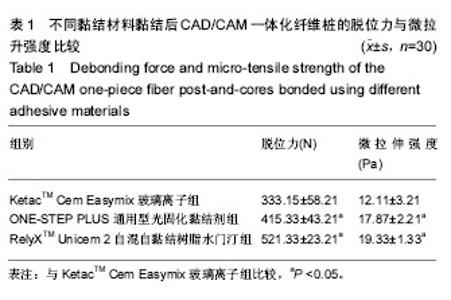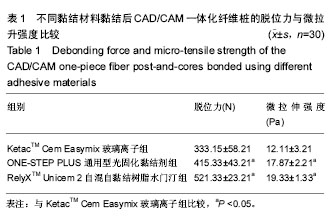| [1] Mizuno Y,Gonda T,Takahashi T,et al.Root Fracture of Abutment Teeth for Partial Removable Dental Prostheses.Int J Prosthodont.2016;29(5):461-466. [2] Souza EM,do Nascimento LM,Maia Filho EM.The impact of post preparation on the residual dentin thickness of maxillary molars.J Prosthet Dent.2011;106(3):184-190.[3] 马轩祥,赵铱民.口腔修复学[M].5版.北京:人民卫生出版社, 2007:95.[4] Paes da Silva Ramos Fernandes LM,Rice D,Ordinola-Zapata R,et al.Detection of Various Anatomic Patterns of Root Canals in Mandibular Incisors Using Digital Periapical Radiography, 3 Cone-beam Computed Tomographic Scanners, and Micro-Computed Tomographic Imaging.J Endod. 2014;40(1): 42-45.[5] Wu MK,R'oris A,Barkis D,et al.Prevalence and extent of long oval canals in the apical third. Oral Surg Oral Med Oral Pathol Oral Radiol Endod.2000;89(6):739-743.[6] Zogheib C,Hanna M,Pasqualini D,et al.Quantitative volumetric analysis of cross-linked gutta-percha obturators. Ann Stomatol(Roma).2017;7(3):46-51.[7] 刘鹏,李亚南,姜慧,等.CAD/CAM一体化玻璃纤维桩核抗折力的体外实验研究[J].北京口腔医学,2010,18(2):90-93.[8] Robson H,Specht K,Beaumont H,et al.Influence of different luting protocols on shear bond strength of computer aided design/computer aided manufacturing resin nanoceramic material to dentin.Dent Res J(Isfahan). 2016;13(2):91-97.[9] Wu MK,Roris A,Barkis D,et al.Prevalence and extent of long oval canals in apical third.Oral Surg Oral Med Oral Pathol Oral Radiol Endod.2000;89(6):739-743.[10] Paes da Silva Ramos Fernandes LM,Rice D,Ordinola-Zapata R,et al.Detection of various anatomic patterns of root canals in mandibular incisors using digital periapical radiography, 3 cone-beam computed tomographic scanners, and micro-computed tomographic imaging.J Endod. 2014;40(1): 42-45.[11] Hegde J,Ramakrishna,Bashetty K,et al.An in vitro evaluation of fracture strength of endodontically treated teeth with simulated flared root canals restored with different post and core systems.Conserv Dent.2012;15(3):223-227.[12] Dua N,Kumar B,Arunagiri D,et al.Comparative evaluation of the effect of different crown ferrule designs on the fracture resistance of endodontically treated mandibular premolars restored with fiber posts, composite cores, and crowns: An ex-vivo study.J Conserv Dent.2016;19(3):264-269.[13] Gaikwad A,Pal KS,Ranganath LM,et al. Fracture Resistance of Teeth Restored with Various Post Designs and Cemented with Different Cements: An In-vitro Study. J Int Oral Health. 2015;7(Suppl 1):33-37.[14] Manor Y,Bader A,Chaushu G,et al.How Patients Percept Their Recovery Following Impacted Mandibular Third Molar Coronectomy.J Craniofac Surg.2016;27(3):671-674. [15] Magne P,Carvalho AO,Bruzi G,et al.Influence of no-ferrule and no-post buildup design on the fatigue resistance of endodontically treated molars restored with resin nanoceramic CAD/CAM crowns.Oper Dent. 2014;39(6): 595-602.[16] Kontogiorgos ED,Gharpure P,Iheanacho EO,et al.Preclinical Evaluation of a Crown-Splinted Custom Root-Shaped Implant. Int J Oral Maxillofac Implants.2017;32(5):1023-1032. [17] Panitiwat P,Salimee P.Effect of different composite core materials on fracture resistance of endodontically treated teeth restored with FRC posts.J Appl Oral Sci. 2017;25(2): 203-210.[18] Gloria A,Maietta S,Martorelli M,et al. FE analysis of conceptual hybrid composite endodontic post designs in anterior teeth.Dent Mater.2018;4(18):30284-30287.[19] Scotti N,Forniglia A,Bergantin E,et al.Fibre post adaptation and bond strength in oval canals.Int Endod J. 2014;47(4): 366-372. [20] 冯昌芬,逄键梁,刘冰,等. CAD/CAM一体化纤维桩核修复薄弱根管的冠向微渗漏研究[J].实用口腔医学杂志, 2016,32(3): 321-324.[21] Wendler M,Belli R,Valladares D,et al.Chairside CAD/CAM materials. Part 3: Cyclic fatigue parameters and lifetime predictions.Dent Mater. 2018;4(17):31313-31311. [22] Manicardi CA,Versiani MA,Saquy PC,et al.Influence of filling materials on the bonding interface of thin-walled roots reinforced with resin and quartz fiber posts.J Endod. 2011; 37(4):531-537. [23] Debnath A,Kesavappa SB,Singh GP,et al.Comparative Evaluation of Antibacterial and Adhesive Properties of Chitosan Modified Glass Ionomer Cement and Conventional Glass Ionomer Cement: an In vitro Study.J Clin Diagn Res. 2017;11(3):75-78. [24] Dittmer R,Schaefer CM,Fischer JF, et al. Advanced CerMet ceramic composites for medical applications. J Mech Behav Biomed Mater. 2017;11(75):206-211. [25] Ingle JI,Bakland LK.Endodontic6[M].PMPH-USA,2002:1032.[26] Ulusoy AT,Tunc ES,Bayrak ?.Clinical performance of a glass ionomer sealant protected with two different resin-based agents over a 2-year follow-up period.Eur J Paediatr Dent. 2017;8(1):10-14. [27] Kuhn E,Reis A,Chibinski AC,et al.The influence of the lining material on the repair of the infected dentin in young permanent molars after restoration: A randomized clinical tria. J Conserv Dent.2016;19(6):516-521.[28] Kasraei S,Yarmohammadi E,Ghazizadeh MV.Microshear Bond Strength of OptiBond All-in-One Self-adhesive Agent to Er:YAG Laser Treated Enamel After Thermocycling and Water Storage.J Lasers Med Sci.2016;7(3):152-158. [29] Sato T,Takagaki T,Matsui N,et al.Morphological Evaluation of the Adhesive/Enamel interfaces of Two-step Self-etching Adhesives and Multimode One-bottle Self-etching Adhesives. J Adhes Dent. 2016;18(3):223-229.[30] Mensi C,Ciullo F,Barbieri GP,et al.Pleural malignant mesothelioma in dental laboratory technicians: A case series. Am J Ind Med.2017;60(5):443-448. [31] Ozel E,Cildir A,Ozel Y,et al. Re-attachment of anterior tooth fragment using a self-etching adhesive: a case report. J Contemp Dent Pract.2008;9(1):77-83.[32] Chauhan R,Tikku A,Chandra A.Detection of residual obturation material after root canal retreatment with three different techniques using a dental operating microscope and a stereomicroscope: An in vitro comparative evaluation.J Conserv Dent.2012;15(3):218-222.[33] Celerino de Moraes Porto IC,de Sousa Gomes Costa JL,Nascimento da Silva Lopes MR,et al.Effect of dentin pretreatment with potassium oxalate: A 6-year follow-up. Microsc Res Tech. 2017;12(10):1002-1010. [34] Muhsin SA.Bond Strength of Repaired Acrylic Denture Teeth Using Visible Light Cure Composite Resin.Open Dent J. 2017;31(11):57-64.[35] Neelakantan P,Subbarao C,Subbarao CV,et al.The impact of root dentine conditioning on sealing ability and push-out bond strength of an epoxy resin root canal sealer.Int Endod J. 2011; 44(6):491-498.[36] Kim YK,Mai S,Mazzoni A,et al.Biomimetic remineralization as a progressive dehydration mechanism of collagen matrices--implications in the aging of resin-dentin bonds.Acta Biomater. 2010;6(9):3729-3739.[37] Menezes-Silva R,Pereira FV,Santos MH,et al.Biocompatibility of a New Dental Glass Ionomer Cement with Cellulose Microfibers and Cellulose Nanocrystals.Braz Dent J. 2017; 28(2):172-178.[38] Medeiros Serpa EB,Clementino MA,Granville-Garcia AF,et al.The effect of atraumatic restorative treatment on adhesive restorations for dental caries in deciduous molars.J Indian Soc Pedod Prev Dent.2017;35(2):167-173. [39] Boing TF,Gomes GM,Gomes JC,et al.Is the bonding of self-adhesive cement sensitive to root region and curing mode?J Appl Oral Sci.2017;25(1):2-9. |

